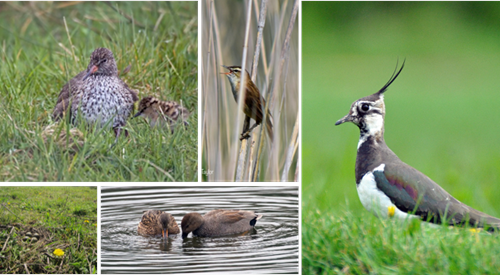The Avon Valley supports a nationally important assemblage of breeding wetland birds. Although we have selected waders due to their significant declines, our management has the potential to benefit the breeding populations across avian taxa from small songbirds like sedge warblers which utilise the vegetation at the edges of our ditches of forage to ducks like Gadwall which benefit from increased wetness and in-field wet features.
We undertake regular breeding bird surveys throughout the spring during which all wetland associate birds are recorded. The key outcome of these surveys are data on breeding wader abundance, but the method also provides monitoring for species such as Sedge Warbler, Reed Bunting and Gadwall.

So far on our water meadow surveys of hotspot sites, we have recorded 24 amber-listed birds and 7 red-listed birds. The later is highest conservation category given to British birds, with our surveys including Cuckoo, Curlew, Herring Gull, Skylark, Grey Wagtail, Whinchat and Nightingale.
Breeding lapwing are monitored most intensively as our key species demonstrating the quality of the wet meadow grassland. For this species we undertake detailed pair counts and collect data on nest and chick survival. Nests are monitored using small temperature loggers (1cm diameter) which allow us to identify the outcome of a nest based on knowledge of the trend in temperature shown by successfully incubated and hatched nests compared to those which are predated or abandoned. As a result of improving breeding success due to LIFE Waders for Real, our current estimate of the lapwing population is 70 pairs. We are hoping to reach a target of 90-100 pairs by the end of the project. We currently hold 30 pairs of breeding redshank, with chicks fledging inside our predator exclusion fencing. We have created more suitable swards for redshank and with protection from predation, we are hopeful of seeing increase in this species by the end of the project.